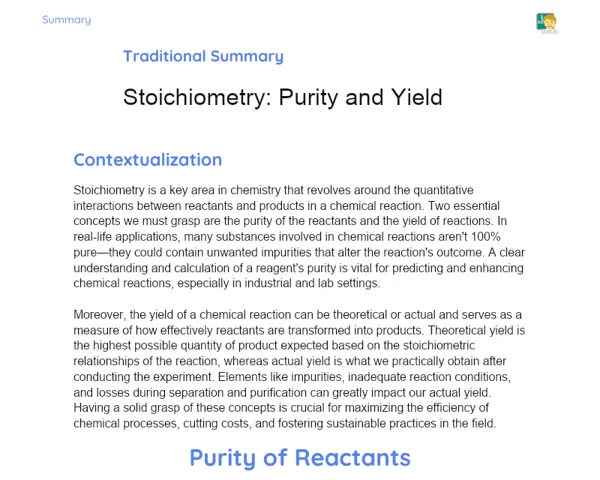Socioemotional Summary Conclusion
Goals
1. Name esters accurately using IUPAC rules.
2. Understand how ester nomenclature differs from that of other organic compounds.
Contextualization
Ever wondered why a strawberry candy has that unique aroma and taste? It’s all thanks to esters – organic compounds that play a vital role in everything from artificial food flavours to perfumes. Learning the names of these compounds not only helps us grasp the chemistry behind everyday products, but also reminds us of the precision and care needed in our daily work and decisions. 🌟
Exercising Your Knowledge
Understanding Esters
Esters are organic compounds that come from carboxylic acids. In an ester, the hydroxyl (-OH) group is replaced by an alkyl (-OR) group. We represent them by the general formula R-COO-R'. Esters are common in nature – you can find them in aromas and flavouring agents, which makes them very important both in daily life and in industrial applications.
-
Essence of Esters: Originating from carboxylic acids, they are a fundamental part of organic chemistry.
-
General Formula: Denoted as R-COO-R', where the -OH group is replaced by an alkyl group.
-
Practical Uses: Widely used in artificial aromas and flavourings, showing their everyday relevance.
IUPAC Naming for Esters
The IUPAC naming convention for esters involves two parts: first, the name of the alkyl group (R') is mentioned, followed by the name of the parent carboxylic acid transformed to end with ‘-ate’. For instance, when ethanol reacts with acetic acid, the resulting ester is called ‘ethyl acetate’.
-
Naming Structure: Start with the name of the alkyl group (R') and then name the carboxylic acid with an ‘-ate’ ending.
-
Key Example: Ethyl acetate, produced from ethanol and acetic acid.
-
Why It Matters: Clear and standard naming is crucial for effective scientific communication.
Esters in Everyday Life
Esters are everywhere – in perfumes, foods, and even in some medicines. Knowing about these compounds gives a deeper insight into how chemistry touches our daily lives.
-
Aromas and Fragrances: Used extensively in producing artificial aromas for perfumes and foods.
-
Medicine: Many medications include esters, highlighting their versatile applications.
-
Daily Connection: They show us that chemistry is part of our everyday experiences, from the taste of a candy to the fragrance of a perfume.
Key Terms
-
Ester: An organic compound derived from a carboxylic acid where the -OH group is replaced by an -OR group.
-
Alkyl Group: A part of the ester that comes from an alkane after removing a hydrogen atom.
-
IUPAC Nomenclature: A globally accepted system for naming chemical compounds.
For Reflection
-
How might precise ester naming influence other areas of science and everyday practices?
-
What emotions did you experience while learning about ester nomenclature, and how did you manage them?
-
How can skills like teamwork and self-control help you understand complex concepts like the chemistry of esters?
Important Conclusions
-
Esters are significant organic compounds derived from carboxylic acids and are widely utilised in creating aromas and flavourings.
-
The IUPAC system for naming esters is essential for clear scientific communication, based on naming the alkyl group followed by the carboxylic acid name with an '-ate' suffix.
-
Recognising how esters and their nomenclature are integrated into everyday life, such as in candies and perfumes, enriches our appreciation of chemistry.
Impacts on Society
Esters have a considerable role in today’s world, particularly in the food and cosmetics industries. They are responsible for the synthetic aromas and flavours in many common products – for example, the way a strawberry candy smells or how a perfume’s scent is reproduced in the lab. This not only enhances product appeal but also allows for more controlled, sustainable production. In pharmaceuticals, esters are often found in drug formulations, underscoring their versatility and importance in boosting public health.
The connection with esters goes beyond technical chemistry. When students realise that these compounds influence everyday sensory experiences – be it a flower’s scent or a fruit’s taste – it can foster a deeper love for science. This clarity in precision also teaches valuable lessons in careful and thoughtful decision-making, which can encourage a more meticulous approach in studies and life.
Dealing with Emotions
Try this exercise at home to manage your emotions when studying esters: First, take note of your feelings when faced with a tough chemistry problem, like identifying an ester. Ask yourself: ‘Am I feeling frustrated, curious or excited?’ Then, try to understand why you feel that way – maybe initial difficulty causes frustration, or new discoveries spark curiosity. Label that emotion clearly, for example, 'I feel frustrated because I couldn’t understand it right away.' Next, express it in a healthy way – perhaps saying, 'I will take a short break, breathe deeply, and then try again.' Finally, use techniques like the conscious breathing practice we discussed in class to regain focus and calm. Reflect on how this method helps you handle challenging topics.
Study Tips
-
Revise and practise regularly to get comfortable with ester nomenclature. Using flashcards for names and formulas can be very effective.
-
Create relatable analogies or stories to remember ester structures. Linking new information to personal experiences can make learning much more engaging.
-
Participate in study groups or online discussions to clear doubts and exchange ideas. Working together often brings fresh insights and easier ways to solve problems.



